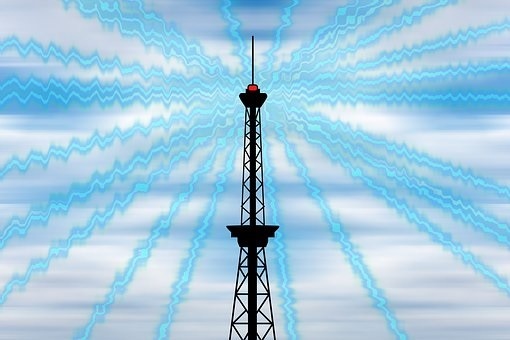Fear of Wireless: Emotions Getting the Better of UsFear of Wireless: Emotions Getting the Better of Us
Rational or not, concerns over exposure to radio waves are rising again with 5G’s advent, and this could impact enterprise mobility initiatives.
August 5, 2019

Long ago, I learned that if you’re involved in an argument that pits logic against emotion, the argument is over before it begins: Emotion wins. Think about the anti-vaxers, who continue to believe in a link between the measles vaccine and autism, despite all evidence to the contrary. I see a parallel example in the persistent concern about exposure to radio frequency (RF) signals.
RF-phobia has deep roots… and an unfortunate association with some real hazards.
Worry Warranted, or Not?
Radio waves are effectively electromagnetic radiation, a type of radiation characterized by frequency. Technically, radio waves occupy the band between 30 KHz and 300 GHz (or 30,000 to 300 billion hertz), but the electromagnetic spectrum goes beyond that to encompass infrared light, visible light (i.e., 430 to 770 terahertz), and beyond. Traditional cellular networks have operated at frequencies below 3 GHz, and 5G will introduce millimeter waves operating at frequencies up to around 30 GHz.
The human body absorbs radio energy at those frequencies and this radio energy can cause heating in human tissue. We use a metric called specific absorption rate, expressed in watts per kilogram of body weight, to measure the absorbed dose of that energy.
The Federal Communications Commission sets the maximum emission for any device, and the assumption is that lower-frequency waves are benign. However, moving higher in the spectrum, beyond the range of visible light, electromagnetic radiation can cause ionization -- now that’s bad. Ionizing means you’re knocking electrons free from atoms or molecules. Changing the atomic structure of a thing means changing what it is. In addition, that ionizing radiation can break chemical bonds in DNA, leading to cancer.
However, the radio waves we use in Wi-Fi, cell phones, 5G, and other wireless applications are well down in the “non-ionizing” range, which means they don’t produce an ionization effect. Knowing that we’re dealing with non-ionizing radiation should put our minds to rest, but not if you’re someone who likes to worry.
I’m not a worrier. My wife likes to worry, so I leave the household worrying responsibilities to her. Me, I take a big-picture view. The way I look at it, as humans we’ve been exposed to electromagnetic radiation at a wide range of frequencies and power levels in the natural environment throughout history. We’ve also been exposed to human-generated RF emissions for the past century. In the last 30 years, billions of people have been using personal cellular radio devices in close proximity to their bodies. If non-ionizing radiation were a major health hazard, people would be dropping dead left and right.
The National Cancer Institute (NCI) seems to agree. “Most published analyses … have shown no statistically significant increases in brain or other central nervous system cancers related to higher amounts of cell phone use,” the organization shares on its website. While that should put most reasonable minds to rest on the matter, the NCI goes on to say, “One analysis showed a statistically significant, although modest, increase in the risk of glioma among the small proportion of study participants who spent the most total time on cell phone calls.”
Oh boy. The reality is that for their own protection, scientists are never going to say “never” on an issue like this. Unfortunately, that leaves a wide-open opportunity for people who enjoy worrying to continue their favorite pastime.
Worriers can cite 30 years’ worth of studies that find you can generate all manner of “peculiarities” by bombarding human tissues with levels of RF energy almost no one will ever experience. Google the phrase “cell phone effects on health” and you’ll get something like 347 million results.
If a “real” health concern regarding wireless should emerge, we in the wireless field would need to know about it, so I’ve looked into virtually every report or study published on potential health effects from cell phones for the last 30 years. These three statements summarize the conclusions from each of these studies:
We didn’t find any direct causal link to cancer.
We did find some interesting effects that might have some relationship to human health.
Further study is needed.
Click below to continue to Page 2
Wireless on the Home Front
These questionable health concerns rarely if ever come up in my day-to-day life installing wireless solutions for businesses, but I came face to face with the issue in the little village of 155 homes where I live on the south shore of Long Island.
About a year ago, cell tower operator Crown Castle requested authorization to install a distributed antenna system (yes, you can install DAS outdoors as well as indoors) to improve cell phone service in our area. It mailed a routine announcement to residents, and I was the only citizen to attend the public hearing. Our mayor (who I know in passing) was wondering why I’d even bother to show up, but I told him I had been in the wireless business for 25+ years, and I’d never attended a local cell site review so I wanted to see what it was like.
In the end, it was pretty boring. At the outset, the town attorney read a prepared statement that basically said that while there are concerns about the health effects of RF exposure, the FCC says the exposure is OK. So, the attorney continued, unless you can prove the FCC wrong, health concerns legally can’t be a cause to deny the application.
The first site went in, no one seemed to notice (except maybe the customers who started getting better cell service), and life continued happily in my bucolic village.
About a year later, Crown Castle made a second DAS application, Suddenly, all hell broke loose. At this second town meeting I had the company of more than 70 people, including folks from the adjacent village. The town attorney read that same statement about the FCC, but apparently no one had listened.
What followed was an hour’s worth of hand-wringing and concern that brought up visions of grandchildren playing in backyards while being pummeled with heinous, cancer-causing radiation. Ours is an upscale neighborhood, so the speakers voicing these concerns weren’t crazy cat ladies, but a number of medical doctors and other educated professionals.
I did consider raising the importance of having good cellular coverage to reach emergency services, particularly when virtually all of our wired phones went out of service with Superstorm Sandy a few years back, but I knew better. I also knew, given that attorney’s statement about the FCC, that all of this hand-wringing wasn’t likely going to stop progress on the DAS deployment.
Conclusion -- Be Prepared
In “American Tune,” one of my favorite Paul Simon songs, there’s a lament that goes, “You can't be forever blessed.” The song’s theme is that life is terrible, we’ve lost our way, and concludes with the assessment that it’s best just to go to bed because “tomorrow's going to be another working day” -- depressing theme but great guitar work. The underlying theme seems to be that despite all of the progress we’ve made as a society, it’s still everyone’s God-given right to be depressed about something, so go for it.
To the sober eye, cheap, reliable wireless communications is one of the greatest capabilities our industry has been able to deliver to mankind. Sure, a lot of what is being done over wireless still falls in the category of “pointless frivolity,” but I always remind people that sound infrastructure is essential to modern society. Today, if you’re calling the cops or the fire department, you’re probably calling on a cell phone.
Of course, my personal beliefs have absolutely nothing to do with this, but consumer resistance to the infrastructure we need to provide essential wireless services represents a serious “business problem,” and we do need to deal with business problems.
We’ve already seen parental pressure to ban the installation of Wi-Fi in schools, and as most important technology developments now begin in the consumer environment, this is something that could definitely become an issue in the workplace -- even in the public areas of our businesses.
In short, while we might like to laugh this one away, the concerns being expressed, rational or irrational, do exist, and we may be called upon to address them. Current science is clearly on the side of wireless, but we must be cautious in presenting our case to the dubious. The arguments we’re making are based on logic and fact, but dealing with emotion is a whole different animal.
 Michael Finneran is writing on behalf of BCStrategies, an industry resource for enterprises, vendors, system integrators, and anyone interested in the growing business communications arena. A supplier of objective information on business communications, BCStrategies is supported by an alliance of leading communication industry advisors, analysts, and consultants who have worked in the various segments of the dynamic business communications market.
Michael Finneran is writing on behalf of BCStrategies, an industry resource for enterprises, vendors, system integrators, and anyone interested in the growing business communications arena. A supplier of objective information on business communications, BCStrategies is supported by an alliance of leading communication industry advisors, analysts, and consultants who have worked in the various segments of the dynamic business communications market.





